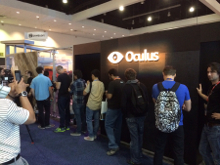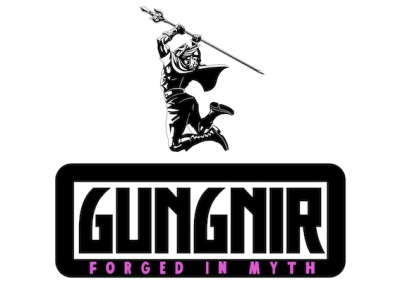 Virtual reality is virtually real as a consumer technology. What next?
Virtual reality is virtually real as a consumer technology. What next?This year’s Electronic Entertainment Expo (E3) featured the usual slew of announcements and previews of highly anticipated videogames, but there was only one thing people were talking about on the floor. "Did you do the demos?"
The demos in question are for two competing products offering something gamers, sci-fi geeks and solipsistic recluses the world over have been drooling for since William Gibson first promised it to us in the pages of his 1983 novel Neuromancer: full-on sensory emersion in a vivid, real-time digital environment.
Virtual reality. For real.
Yeah, I know, we’ve heard this before. In the 1990’s, VR went from dream to hype to joke faster than you could say "Mondo 2000." Well no one is laughing now.
Tripping the Rift. For the past few years, an Orange County, CA-based startup called Oculus has been carrying the dreams of the VRati forward with their Rift headset. First the company lit up Kickstarter with one of the most successful campaigns ever, and then earlier this year, they were acquired for a cool $2 billion without having shipped their first product.
Now the device is ready for prime time and everyone at E3 wanted a look. Lines circled their centrally-located booth for the duration of the show as people waited hours for the chance to dip into a simulated digital world.
I had a chance to jack in to the Rift for a five-minute tour, on the least compelling of the four demo scenarios (a colorful third-person platform game reminiscent of Sonic the Hedgehog). Once the headgear was fitted and the controller placed in my hand, I was surrounded by a true 3D environment where I could turn my head to look independent of the motion or direction of the character in the game, perceive objects in the distance with depth perception and parallax, and interact with objects in the world so convincingly that I immediately forgot that I was in the middle of a crowded convention hall, packed shoulder to shoulder with fellow demo-takers and staff.
Yes, it was all that. But that was nothing compared to the other VR headset to debut at the show, Sony’s Project Morpheus.
Enter Sandman. Project Morpheus is the same idea as the Oculus Rift: binocular headgear displaying high-res, high-frame rate digital imagery to simulate the sensation of being in a 3D environment. However, it’s tied more closely to a single gaming platform and ecosystem.
My Morpheus demo was literally immersive. In the scenario, I was trapped in a metal diving cage dozens of feet below the surface, surrounded by sharks. I could look up at the light shimmering through the clear water, down at the murky depths, around at the various fish and debris that floated past, or straight ahead into a disconcertingly lifelike Great White. By the end of the three minute simulation, I was short of breath, as though I’d actually been underwater.
Predators or Shark Bait? Both the Oculus Rift and the Sony Morpheus leave no doubt that the technology itself is good enough to deliver the experience technophiles have been waiting for. The questions have been on the business side. And it’s reasonable to ask whether Oculus, which is essentially still a startup (albeit one with formidable financial backing) can manage the launch of a product with such revolutionary potential.
Project Morpheus is another story. It is about to become the flagship product of one of the world’s largest consumer electronics companies--one which has been under considerable pressure lately and is badly in need of a breakthrough to consolidate its recent lead over Microsoft in the gaming console wars.
Once Sony fires the first shot, you can bet that Samsung, Microsoft and plenty of others will follow suit as fast as they can move their own prototypes out of the lab and into production. If consumer VR doesn’t reach market scale in the next year or two, it won’t be for lack of effort.
Ready Player One. Once that happens, we’re in a brand new world. The immediate transformative potential of this technology on gaming is obvious, but if mainstream consumer electronics companies can bring this to market at an affordable price point, it could be the most disruptive social innovation since the advent of the Internet itself.
Consider the potential impact on the way we consume video entertainment. Even if you’re not a gamer, head-mounted 3D displays offer an upgrade to just about every other video viewing technology out there. Who needs an 80-inch LCD screen taking up wall space when you can wear a device that completely surrounds you with the program? Imagine watching The Avengers or Lord of the Rings with something like that. Even IMAX 3D pales in comparison. And in a future where more and more people will be living in smaller spaces, surrounded by less physical stuff, head-mounted displays extend high-end viewing experiences to just about anyone.
Consensual Hallucination. Of course, the full-fledged Gibson/Stephenson/Mondo 2000 version of VR is not just about sitting alone in the dark watching X-Men movies. It’s a social experience, where each individual is interacting in a shared virtual world. Social VR. Crazy, right? Did I mention that the company that paid $2 billion for Oculus was Facebook?
Videogames have been optimizing the shared multi-user experience for the past 10 years, and the network infrastructure for distributed VR is essentially already in place. It’s just a matter of bringing the Halo or World of Warcraft or SecondLife environment to a new display device.
And then what? Virtual, immersive telepresence could enable all kinds of new social experiences, from the obvious (porn) to real-time meeting places, retail stores, festivals, even conventions. Imagine a vast, never-ending virtual con community that anyone can attend through a 3D interface, with no ticket scramble, no Hoteloween and no lines for the bathrooms.
Or a fan-oriented retail experience where you could select a digital comic off a spinner rack or endless bookshelf, discuss it with friends, then page through it as though you were holding it in your hand? I’ll bet there are companies now backed by a lot of money and a strong interest in selling you digital comics working on that.
Thirty years of cyberpunk has given us lots of scenarios to kick around for how networked VR systems can mess with our culture, markets and social structures. If the ready-for-prime-time tech on display at E3 is any indication, we’re about to find out how right they were.
--Rob Salkowitz (@robsalk) is author of Comic-Con and the Business of Pop Culture and a business consultant in Seattle.
The opinions expressed in this column are solely those of the writer, and do not necessarily reflect the views of the editorial staff of ICv2.com.









